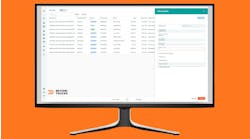Driver attention and engagement key to virtual training success
This is Part II of our feature on blended training in the transportation sector. Read Part I here.
In a recent interview with FleetOwner, Luma co-founder CEO Gina Anderson discussed how COVID-19 has presented an opportunity to digitize and innovate the driver training experience as well as to reflect on what the industry should leave behind
“The thing that shouldn't happen is going back to the classroom: having the instructor standing in front of the classroom disseminating information with a screen in front of them,” said Anderson, who holds a doctorate in instructional systems technology from Indiana University.
That’s because the spectrum of how people learn varies greatly, she said.
“To be able to reach all learning and all ability levels, you have to have a combination,” Anderson said.
The conventional way of showing a series of videos over several hours in a dark room and expecting people to retain that knowledge defies the data. Anderson said that the typical attention span for videos is 8.5 seconds as opposed to 30 seconds in real life. And to retain information, people need to see something seven to nine times. That is not a good combination if the goal is to have drivers learn anything away from a particular training session.
It also explains why Upstaging had to play hide-and-seek with drivers to get them to sit and watch the training videos.
Anderson noted that despite the need for multiple approaches and events to dig those neural pathways to long-term memory, oftentimes crucial knowledge, such as with hazmat and cargo securement rules and practices, are conveyed only once.
“These things that are life-and-death situations, you're seeing one time in such a complex way,” she said. That type of training, she suggested, requires a mix of practical and theoretical sessions.
When Anderson began auditing driver training sessions about seven years ago, as Luma was transitioning from K-12 education and government work to the transportation sector, she noticed “everybody was falling asleep, they were looking at their phones, and they were not paying attention.”
“The first step in learning is getting somebody’s attention,” she said.
And videos alone did not command that needed attention. Probably because of the general inefficiency of the old-school classroom format, drivers prefer video learning only 14% of the time, according to Luma research. A good driver is taught to pay attention to everything around them and always keep moving, but these are skills that don’t translate well to a classroom setting.
Part of Luma’s strategy is to employ micro-learning, a way to hack the brain to make new information stick. The technique is based off repetition, strengthening recall, repetition, and assessing confidence in subject matter. Oh, and repetition.
“The idea is that you've continually reinforced those short lessons over time to be able to help it commit to long-term memory,” Anderson explained.
Luma calls its microlearning “eNuggets,” which include five to nine details to learn. The courses take five to eight minutes, and learners may view a particular eNugget three times a month.
Making the information relevant to the specific audience also helps stretch out that attention span .
North Dakota-based Britton Transport, a fleet of 150 units, cut driver orientation time by 50% using eNuggets.
“If you're giving content that is authentic, real, and meaningful, and specific to the company, that's going to make all the difference,” Anderson said.
Fleets that use Luma’s interactive teleconferencing portal, Luma Live System, found virtual training means keeping more cash. According to Luma, America’s Service Line saved $88,000 in training and orientation costs; Forward Air Corp saved $1,000 per driver during orientation—with 1,000 drivers going through the program; and R.B. Steward reduced hazmat training costs by 75% with Luma.
One final point about online training: As anyone subjected to the onslaught of virtual conferences and webinars can attest, the ability of the presenter to communicate in an engaging manner is crucial.
“When people are sitting in their cab or at home at their desk and watching somebody on camera, that weaker quality delivery is harder to pay attention to. it's way easier for them to zone out,” CarriersEdge CEO Mark Murrell said. “So, if you're delivering content in a virtual setting, you really have to step up your game.”
Murrell advised that the presenter remain engaging and energetic due to the number of distractions assailing the viewer—from emails or texts on their devices to noises or motion within ear and eyeshot.
The more customized and interactive a session is, which may include surveys or more fluid open discussion, the more likely drivers will stay interested.
Keeping it real
You can only do so much with online tests and presentations, even really good ones. Unlike many newer remote learners, drivers have been working out of “home offices”—trucks—for many decades. And they are responsible for understanding, at least on some level, everything between the tractor grille and trailer tailgate. That type of hands-on learning isn’t going anywhere. But it is changing.
Luma has discussion boards that allow drivers to discuss issues and questions with their peers, or even post videos of themselves securing a load, and then asking for comments on how they can improve. For example, a driver will have a friend or family member record them on a smartphone fastening a load, or conducting an entire pre-check. Then they post the video on the discussion board and ask for critiques. Anderson noted that female drivers are more engaged in this method of learning, rather than asking a question in real time in front of a large audience of mostly males.
Creative methods such as this, combined with the theoretical approach discussed in self-study and virtual meetings, as well as in-person training where the driver will physically manipulate a ratchet strap or similar tie-down device, is exactly what Anderson believes is the best practice going forward.
“Cargo securement is a really interesting example of a situation where you need multiple approaches, because, yes, you absolutely need the practical part of doing it. But the practical part doesn't really get you anywhere if you don't understand the theory behind it,” she said. “Once you know that theory, the next step is definitely to get out there and practice doing it.”
Since the mid-2000s, Schneider has used driving simulators akin to those used in aviation and the military. These comprise a seat, shifter, and other controls, and three large screens—the center for the road and left and right imitate the sideview mirrors.
“The screen moves, so if you go on a curve or if you were to leave the roadway, it has a very real sensation of driving,” said Tom DiSalvi, Schneider vice president of safety, driver training, and compliance.
This also helps with that repetition element, allowing drivers to face challenges again and again in a safe environment.
“We can create scenarios that someone might encounter on the road, such as a tire blowout or black ice, and do it again and again until they feel a degree of comfort so that if they were to be exposed to that in the real world, they could revert back to what they experienced in simulation,” DiSalvi explained.
And now that more fleets are understanding the benefits of basic virtual environments, the stage is set for more innovation and improvement to make training easier, less costly, and more effective.
“We will continue to look at these emerging technologies, with virtual reality and augmented reality,” DiSalvi said. “Those would all be logical things for us to explore as part of a part of a virtual world.”
Virtual training from manufacturers
Fleet weren't the only ones within the industry to transform their educational practices. Manufacturers also had to retool to ensure distributors and customers stayed apprised of new products. The COVID-19 pandemic caused an unfathomable amount of separation anxiety across the world, and the relationships between OEM and supplier sales teams and their dealer and fleet customers were no exception. These were bonds forged over tradeshow booth and customer center visits, lunches and dinners and random encounters. And they allowed customers to touch and feel the product, as well as ask the questions to experts not listed in the literature.
When Volvo Trucks pulled out of CONEXPO 2020, it knew it would have to come up with a new way to showcase its latest Volvo VAH and VHD models. Restrictions made a visit to Greensboro and the Volvo Customer Center impossible, so Volvo created a virtual walkaround so everyone could see the entire chassis and close-ups of specific features and additions while also asking questions and receiving answers in real time
“We learned how valuable it was to ‘virtually’ bring our customers into tight spaces around the truck using a small HD webcam to get the right view, helping them to examine particular component installations, accessories, and even routing and clipping in a remarkably clear and unrestricted way,” explained Rob Simpson, director of Volvo Trucks Customer Center. “This made walk-arounds and truck reviews incredibly efficient, and it also helped customers see items that otherwise might have been impossible to see.”
He said now everyone had the same view, as opposed to those in the back missing out.
“While we could do a great deal in the virtual environment, we cannot replicate the experience customers have when they are physically at a facility,” Simpson said. “However, we have realized that we can now create the best of both worlds as we blend virtual and live experiences for our customers. Given that HD webcams have proven to be so effective, for instance, we will continue using them even during live customer events to provide views of those areas, especially under the truck, that are so difficult to see in-person.”
Hendrickson, which makes suspension and steer axle components, did not want the fruits of those interactions to wither, so they created the Dealer Sales Academy, a series of videos, assessments, and other tools to ensure dealer sales staff were trained on the new equipment Hendrickson has started to roll out, including the Haulmaax EX heavy-duty rubber suspension and three other products to start. After going through the nine modules and a test, the salesperson would receive a certificate. It’s available online and was adapted from Hendrickson’s Service Academy for maintenance technicians.
“The personal relationships are there. You can't substitute that with a video, but we still wanted to get the information out to people,” Jeff Sass, vice president of marketing at Hendrickson, said. He also noted how this allows many more people to receive the training and reduces the team’s travel budget.
Saas said that the training appeals to all types of learners, such as those who retain information better by seeing and those by hearing. And their progress can be tracked via a dashboard.
“The format is quick hitting and yet detailed and repetitive to reinforce the material. Many suppliers provide training that is simplistic; Hendrickson’s requires the student to pay attention in order to pass the course,” said Matt Smart, director of fleet sales, Cumberland International.
Saas also said that the tool can be used to prep customers prior to visits: “There's a lot of opportunity to use this not only as just a virtual training tool but a training tool for the salesmen when they're in front of them.”







